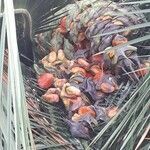Plants caulescent; stem 2-7 m tall, 50-80 cm diam.; 100-120 leaves in crown. Leaves 10-250 cm long, moderately keeled, with 120-220 pinnae, dark green to grey-green, dull to semi-glossy; petiole 2-10 cm long, 22-30 mm wide at lowest pinna. Basal pinnae reducing to spines. Median pinnae simple, 20-35 cm long, 5-10 mm wide, weakly discolorous; margins flat; apex entire, spinescent. Pollen cones fusiform, 30-45 cm long, 10-19 cm diam.; microsporophyll lamina 25-35 mm long, 15-20 mm wide; apical spine 2-25 mm long. Seed cones ovoid, 40-80 cm long, 14-19 cm diam.; megasporophyll with an expanded, peltate apex 4-7 cm wide, 20-30 mm long; apical spine 2-70 mm long. Seeds ovoid, 40-60 mm long, 30-40 mm wide; sarcotesta red.


